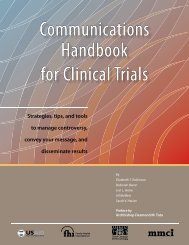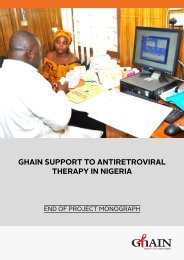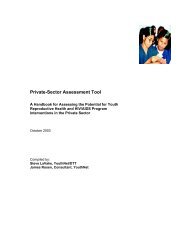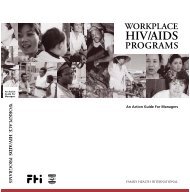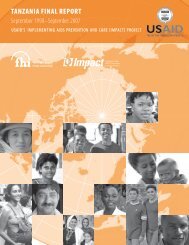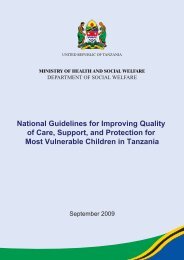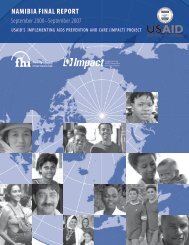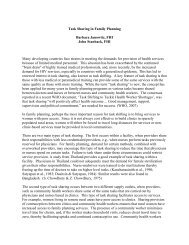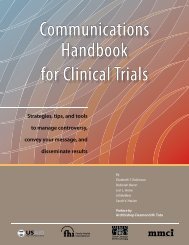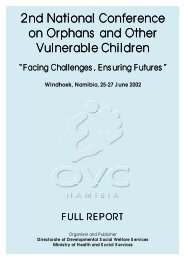Palliative Care Strategy for HIV and other diseases - FHI 360
Palliative Care Strategy for HIV and other diseases - FHI 360
Palliative Care Strategy for HIV and other diseases - FHI 360
Create successful ePaper yourself
Turn your PDF publications into a flip-book with our unique Google optimized e-Paper software.
approach. ICPC integrates support throughout the entire holistic health system, including<br />
primary healthcare facilities <strong>and</strong> their multidisciplinary teams, ART sites <strong>and</strong> their interdisciplinary<br />
care teams, community <strong>and</strong> home-based care groups, support groups, <strong>and</strong><br />
communities <strong>and</strong> families themselves. The integrated service delivery of ICPC makes it<br />
possible to provide a full continuum of palliative care from diagnosis to support end-of-life<br />
care <strong>and</strong> bereavement.<br />
Each component of the ICPC model is critical to its success, but of paramount importance<br />
is the integration of complementary, comprehensive palliative care <strong>and</strong> wellness services<br />
into the existing health structure <strong>and</strong> community-based providers. Provision of integrated<br />
services is the only way that all the continuum of care needs can be met. No one health<br />
provider can address all the physical, emotional, social, <strong>and</strong> spiritual needs of holistic palliative<br />
care <strong>and</strong> wellness support that a pediatric <strong>and</strong>/or adult client has. A team approach<br />
is warranted to meet these complex, chronic care needs.<br />
<strong>Palliative</strong> care training of NDoH health professionals, CHBC caregivers, <strong>and</strong> <strong>other</strong> members<br />
of the multidisciplinary team in each site has been conducted. Additionally, palliative<br />
care training with traditional healers <strong>and</strong> pastors has also assisted in bringing a holistic<br />
approach to the ICPC program. Patients <strong>and</strong> their families have already experienced an<br />
improvement in their quality of care, <strong>and</strong> beneficial links between facility <strong>and</strong> communitybased<br />
services have strengthened the continuum of care.<br />
ethiopia: Community support For ChbC<br />
<strong>FHI</strong>/Ethiopia has been exerting commendable ef<strong>for</strong>ts in implementing comprehensive<br />
community <strong>and</strong> home-based care through community mobilization in 14 communities<br />
since October 2004. The program has made a significant difference in quality of life at the<br />
individual, family, <strong>and</strong> community level.<br />
The CHBC program is the result of a unique partnership between community organizations,<br />
NGOs, <strong>and</strong> governmental organizations. From the very beginning, the implementing<br />
NGO <strong>and</strong> concerned governmental organizations (<strong>HIV</strong>/AIDS prevention <strong>and</strong> control offices<br />
<strong>and</strong> health bureaus [HAPCOs]) worked together in identifying <strong>and</strong> mobilizing idirs or<br />
traditional burial societies. Regional HAPCOs provide funds to fulfill the needed supplies<br />
(medical <strong>and</strong> nonmedical items <strong>and</strong> food). Local administrations provide shelter, in most<br />
cases free of rent, <strong>and</strong> construction materials <strong>for</strong> renovation, rent-free offices <strong>for</strong> CHBC,<br />
<strong>and</strong> l<strong>and</strong> <strong>for</strong> patients whose health status has improved to cultivate <strong>for</strong> income.<br />
The program has resulted in the reduction of self-stigmatization; PL<strong>HIV</strong> communicate<br />
more openly with their families, neighbors, <strong>and</strong> visitors. Participants report being satisfied<br />
with the service <strong>and</strong> are active in identifying new clients as well as organizing self-help<br />
groups. At the family level, there is less stigmatization of family members with signs <strong>and</strong><br />
symptoms of <strong>HIV</strong>, <strong>and</strong> families are willing to accept CHBC caregivers into their households.<br />
There is improved acceptance of the skills transferred from the caregivers to family<br />
members or neighbors in caring <strong>for</strong> the patient.<br />
The introduction of the CHBC program in communities has resulted in visible changes<br />
in the activities of idirs. Idirs have revised their bylaws to provide services be<strong>for</strong>e death,<br />
whereas be<strong>for</strong>e they only helped after the death of a community member. They are actively<br />
involved in identifying patients to be enrolled in the service, are engaged in mobilizing<br />
<strong>Palliative</strong> <strong>Care</strong> <strong>Strategy</strong> <strong>for</strong> <strong>HIV</strong> <strong>and</strong> <strong>other</strong> <strong>diseases</strong><br />
27



